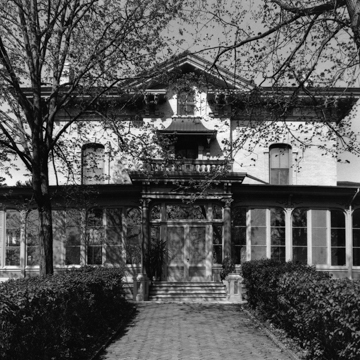High above the banks of the Mississippi River rises Villa Louis, an Italianate manor surrounded by the remains of the once grand estate of the Dousman family. Hercules Dousman, the eldest son of fur traders on Mackinac Island, established himself in Prairie du Chien in the mid-1820s, during the last days of the Upper Mississippi River fur trade. French voyageurs had been journeying to this spot on the edge of the western territories since the seventeenth century, trading beaver pelts, rum, and horses with native peoples. As the fur trade declined, Dousman invested in steamboats, railroads, timber, and land, including this site of the former Fort Crawford on St. Feriole Island. Here he built a red brick house on an ancient Indian mound, which commanded a sweeping view of the landscape.
After his death in 1868, his widow Jane and their son, Louis, replaced the old house with an up-to-date residence. The two-story, cream brick building is Italianate, with deep-bracketed eaves and prominent stone surrounds embracing the arched windows. These basket-handle arches become the dominant motif along the wide veranda, which wraps around the ground floor. Inside, the house incorporated a modern ventilation system, central heating, call bells, and indoor plumbing, befitting the Dousman family’s economic status. Outside, Mix embellished the grounds with a formal garden and a fishpond, fed with waters flowing from an artesian well through an ornamental fountain.
Upon his mother Jane’s death in 1882, Louis and his wife Nina transformed the estate into the Artesian Stock Farm. Harness racing came into vogue after the Civil War, and trendsetters—particularly young men of wealth and leisure like Louis Dousman—pursued the new sport enthusiastically. The rise of the sport’s popularity coincided with the development of American Standardbred trotting horses, noted for speed and endurance. To accommodate almost one hundred of these horses, Dousman built a stable and carriage house, a half-mile oval racetrack, and quarters for the trainer, and he expanded the old estate office from a one-room, one-story block to a five-room two-story structure with a full-height, L-shaped porch.
With the horse farm largely complete in 1885, the Dousmans turned their attention to the interior of the main residence. Joseph Twyman, a British designer with the Chicago firm of John J. McGrath, transformed mundane rooms of pallid hues into rooms with a profusion of color, texture, and pattern, drawing on the Arts and Crafts aesthetic of William Morris. This interior refurbishing was almost finished in January 1886 when thirty-seven-year old Louis Dousman died after a brief illness. His widow renamed the property Villa Louis as an enduring memorial to her husband.
In 1936, the Dousman family and the City of Prairie du Chien opened the doors of the house as a period museum, now owned and operated by the Wisconsin Historical Society.


